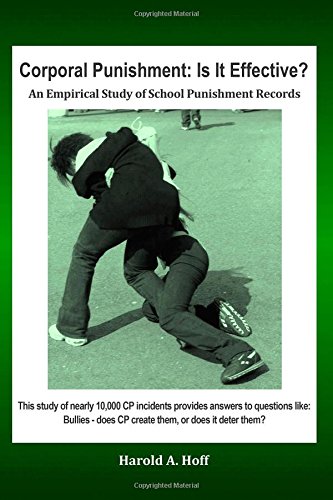CORPORAL PUNISHMENT: IS IT EFFECTIVE? An Empirical Study of School Punishment Recordsby Harold A. Hoff (2014)ISBN 978-1497597488 $16.95 (US) from Amazon.com Review by C. Farrell
To this end, he has managed to collect a quantity of historical punishment book records. They are mainly from the UK but also from Australia and Canada. Since CP in public schools has been abolished in all those places, the data are necessarily somewhat out of date. In total, nearly 10,000 "CP incidents" are accounted for. These Mr Hoff has analysed in enormous detail and with impressive statistical skill, in order to tease out empirical answers to such questions as: • For what kinds of offences is CP more or less effective? "Clear answers are provided to various claims swirling around this issue", says the blurb. Some of these answers will not please the more fanatical anti-CP campaigners. For instance, the data show that CP in the school setting is "extremely effective" in stopping bullying, and is more effective than suspension (which is what has largely replaced CP in many places). There is also some discussion of domestic CP by parents. Naturally, there are no statistical records here. Mr Hoff seeks to show that, in his native Canada, the present law -- which allows parental spanking within certain limits -- should not be made any more restrictive. While that is surely right, I am not really convinced that conclusions about school CP can usefully be applied to domestic CP because, as I have noted in various corners of this website, I think the two settings are too different, in all sorts of ways, to permit of any meaningful "read-across". The author concedes that school CP is unlikely to be brought back in the many places where it has been officially abolished. As he notes, it is likely to be effective only where it is supported by the local community. As far as the developed world is concerned, this now pretty much means Malaysia/Singapore and parts of the southern USA. It would now simply not be accepted by a large enough portion of the population in many parts of the UK, Canada or Australia, or in northern US states, to make it feasible -- however much the statistics may show that it would be useful. To that extent, this most intriguing book has sadly come many years too late. My reservation about the methodology of this impressive work is that it is conflating some quite disparate phenomena. For instance, one of the most copious datasets is actually from a residential reformatory for juvenile delinquents, which is certainly very interesting, but probably so different in its conditions and dynamics from an ordinary local day school that one slightly doubts whether any useful conclusions in respect of the latter can be drawn from the former. We may hope that a future edition might include some data from jurisdictions where school CP is alive and well, notably the still-paddling states of America. For instance, it would be very interesting to know what this kind of statistical breakdown could tell us about small-town Texas, where CP is clearly accepted as a normal and reasonable choice of punishment even (or perhaps especially) by 17- and 18-year olds. I have a suspicion that this might cause one of the author's conclusions, that CP works best with pre-teen students, to be revised. At all events, I think one certainly cannot infer from the data in this book that CP is inappropriate or ineffective for teenage boys in ordinary secondary schools. This book is not lavishly illustrated -- there are two or three generic photographs of school students misbehaving -- but there is a vast number of graphs, charts and statistical tables, enough to provide many hours of pleasure to the more mathematically-minded reader. Those of us who are a bit statistically challenged will have to take some of the more abstruse calculations on trust. |

 The prolific Mr Hoff, author of previous books about corporal punishment
The prolific Mr Hoff, author of previous books about corporal punishment